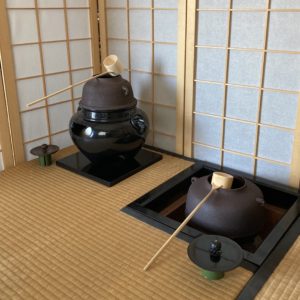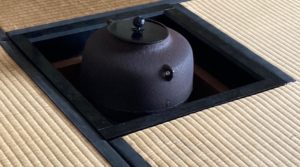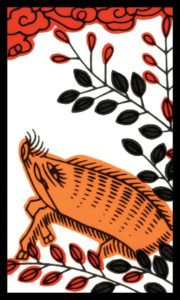Inoshishi Robiraki


Ro-biraki, 炉開, open-hearth, is enacted for use on the first day of the Inoshishi, 亥, Wild boar, in the month of the Inoshishi. The Kanji for the living wild boar animal is inoshishi, 猪. In 2022, the ro is opened on October 25, which is before the ‘official’ first Inoshishi day in the Inoshishi month, which occurs on November 18. The cause of this is that Ri-ttō, 立冬, Start-winter, and the start of the I no Tsuki, 亥の月, Boar’s Month occur on November 7, the day after the day of the Inoshishi on November 6.
Perhaps, because of this kind of calendar discrepancy, Rikyū was asked when to open the ro. He said “when the yuzu turns yellow”. Meaning ‘cold enough’. The yuzu, 柚子, citron-of, Citrus ichangensis x C. reticulata, is a citrus with unique pungent taste and smell that has been a part of Asian cuisine and medicine for centuries.
Why yuzu? It is possible that Rikyū was making a wordplay on the important Buddhist, Yūzū Nen-butsu, 融通念仏, Dissolve-pass through Wish-buddha. The more familiar and simple Nen-butsu, 念仏, Wish-buddha, is the invocation of ‘Namu Amida Butsu’, that is dedicated to the Amida Buddha. By saying his name one may enter Amida’s western, golden Goku-raku Jō-do, 極楽浄土, Ultimate-pleasure Pure-land. It should be remembered that one of Rikyū’s most favored kettles was the Amida-dō gama, 阿弥陀堂釜, Praise-increase-steep-hall kettle. In a Zen temple, the first hearth of the season called kai-ro, 開炉, open-hearth, occurs on the first day of the 10th or 11th month of the lunar year.
The Kanji for kai-ro, 開炉, are reversed for ro-biraki, 炉開. The word kairo has a number of meanings including kai-ro, 薤露, scallion-dew, which refers to the ephemeral nature of the human world, the transience of life, and dew on onion leaves like the tears that mourn a death. These words are found in an ancient Chinese funeral poem. The Kanji kai, 薤, is also read, ra-kkyō, which is the Japanese leek, Allium chinense, Chinese onion. These scallion-like plants are used to make the much relished ra-kkyō zuke, 薤漬け, scallion pickles, and tears are shed when cutting and peeling the bulbs. Scallions and other similar odiferous plants are officially forbidden in Buddhist foods.


Left: neri-kō, 練香, knead-incense, formed into a shi-men-tai, 四面体, four-face-body: L. 2.25 bu kujira-jaku (the kujira mono-sashi, 物差し, thing-distinction, ruler, is shown in the photo). Right: bottle of Seirogan herbal medicine, and one of its beads, and a porcelain container of Kyū-kyo-dō, 鳩居堂, Pigeon-reside-hall, nerikō, and one of its beads.
Incense that is traditionally burned in the ro is neri-kō, 練香, knead-incense, which is a blend of various aromatics mixed with charcoal dust and a kind of honey as a binder. The blended mass is formed into very small balls or beads, and kept in a sealed container to prevent drying-out. When building the charcoal fire in the presence of guests, a piece of nerikō is put into a kō-gō, 香合, incense-gather. The incense bead is formed into a shi-men-tai, 四面体, four-face-body: L. 2.25 bu kujira-jaku. According to Rikyū, the kōgō should be a small ceramic, covered container. Nerikō in its small ball form is like countless Kan-pō-yaku, 漢方薬, China-direction-medicine, Chinese herbal medicine, such as the very popular digestive medication known by its brand name, Sei-ro-gan, 正露丸, Correct-dew-round. In Chanoyu, nerikō is a kind of medication for meditation.

Shiotsuki Sama’s younger brother Hōunsai, who became Iemoto, was born in a year of the Wild Boar. ‘I no shishi’ may evoke wordplay on i no shishi, 井の獅子, well’s lion-of. The word ‘porcelain’ comes from Italian ‘young sow’ with its smooth skin. One of the culinary special dishes in Japan is the bo-tan nabe, 牡丹鍋, male-red pot, a Japanese hot pot stew using wild boar meat. The word botan refers to the deep red color of the flower likened to the petals of the tree peony. In Buddhist custom, one should not eat the flesh of animals, so that animal flesh is given poetic names of plants, such as horse meat is called sakura-niku, 桜肉, cherry-flesh, for the color of the meat likened to the red buds of the cherry, and chiken, niwatori, 鶏, is called kashiwa, 柏, white oak.

Hagi ni inoshishi is the lead card of suit for the 7th month, although this is understood, wrongly, to be July. According to the old calendar, the seventh month begins autumn. In 2022, the 7th month began on July, 29, and autumn began on August 7, and ended with Rittō, 立冬, Start-winter, on November 7. So, in truth, the boar could be bedding down in the fading bush clover. Another name for hagi is fu-sui no toko, 臥猪の床, recline-boar ’s bed. Boars flatten all sorts of plants to make a bed for their rest.
Hagi is one of the ancient aki no nana-kusa, 秋の七草, autumn’s seven-grasses, which are all flowers. The aki no nanakusa are: hagi, (Lespedeza spp.), susuki (Miscanthus sinensis: pampas grass), kuzu (Pueraria Thunbergiana, var typica: arrowroot), nadeshiko (Dianthus superbus), ominaeshi (Patrinia scabiosaefolia), fuji-bakama (Eupatorium japonicum), and ki-kyō 桔梗, , Platycodon glaucum). Hagi is the flower most often mentioned in the Man-yō-shū, 万葉集, Ten thousand-leaves-collection: 142 times.
Wild boars often have many offspring, which makes them emblems of fertility and productivity. Wild boars are also thought to unafraid of fire. The shira-i, 白猪, white-boar, is a messenger of the fire deity.
In a well-known tale, Ō-kuni-nushi, 大国主, Great-country-lord, deity of magic and medicine, who also created Japan, was killed by an aka-i, 赤猪, red wild boar. As it happened, in Ōkuninushi’s land of Izumo, 出雲, Out-clouds, jealous rivals told him there was a red boar on the mountain that will kill you. They set fire to a giant boulder and rolled it down the slope, that Okuninushi thought was the red boar, killed him. Subsequently, the boulder was dubbed akai, red boar. Upon hearing Okuninushi’s mother’s prayers, the heavenly gods, sent to the Earth Kisagahihime, the god of red shells, and Umugihime, the god of clams. They removed his body from the boulder with shells, and with blood and pure water they restored him back to life. Interesting to note that watery things were used to counter the fire of the boulder. Clams are extremely nutritious and beneficial to one’s health.

Rikyū said that the ro should be opened when the yuzu, 柚, citron, turned yellow (Citrus ichangensis x C. reticulata). It was the custom to open the ro on the first day of the I, 亥, (zodiac) wild boar, of the tenth lunar month, which is marked with the same sign of the wild boar. However, that day occurs with great irregularity, and varies by nearly thirty days. The multiple ‘fingers’ are symbolic of the Buddha’s hand that nothing will escape his grasp.

The day after I-no-hi, 亥の日, Boar’s Day, is Ne no Hi, 子の日, Rat’s Day. Much emphasis is placed on the Boar, so that quite often the Rat may be overlooked somewhat. This connection is present in the word i-no-ko, 亥の子, boar’s rat, although the standard Japanese implication is ‘boar’s offspring’. The Kanji ne, 子, has many readings and meanings including rat, seed, child, of, youth, young woman, etc. The two Kanji alone, 亥子, can be read ine, which is wordplay on ine, 稲, meaning ‘rice plant’.

Not to be forgotten at this time, are utensils with designs of the animal of the year, Tora Doshi, 寅年, Tiger-year, and 2022 is a Tiger Year. This author was born in a Tiger Year, 1938.
